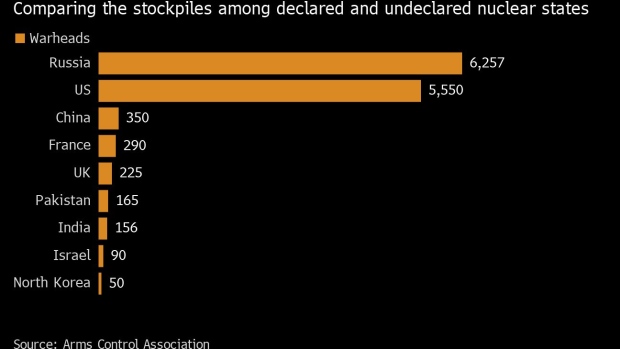Oct 27, 2022
Pentagon’s Strategy Won’t Rule Out Nuclear Use Against Non-Nuclear Threats
, Bloomberg News

(Bloomberg) -- The Pentagon’s new National Defense Strategy rejected limits on using nuclear weapons long championed by arms control advocates and, in the past, by President Joe Biden.
Citing burgeoning threats from China and Russia, the Defense Department said in the document released Thursday that “by the 2030s the United States will, for the first time in its history face two major nuclear powers as strategic competitors and potential adversaries.” In response, the US will “maintain a very high bar for nuclear employment” without ruling out using the weapons in retaliation to a non-nuclear strategic threat to the homeland, US forces abroad or allies.
Biden pledged in his 2020 presidential campaign to declare that the US nuclear arsenal should be used only to deter or retaliate against a nuclear attack, a position blessed by progressive Democrats and reviled by defense hawks. The threat environment has changed dramatically since then, and the Pentagon strategy was forged in cooperation with the White House.
The nuclear report that’s part of the broader strategy said the Biden administration reviewed its nuclear policy and concluded that “No First Use” and “Sole Purpose” policies “would result in an unacceptable level of risk in light of the range of non-nuclear capabilities being developed and fielded by competitors that could inflict strategic-level damage” to the US and allies.
Mackenzie Eaglen, a resident fellow at the American Enterprise Institute, said she is “struck by how strong their position is on nuclear modernization and policy, and how much national security continuity there is between administrations of different parties. They’re willing to postpone their visionary policies in light of the harsh reality on nukes from China and Russia.”
President Vladimir Putin and other Russian officials have openly raised the possibility of using nuclear weapons in their invasion of Ukraine. But on Thursday, Putin said Russia only gave “hints” in response to repeated US and European discussion of a possible nuclear conflict. “We don’t need a nuclear strike on Ukraine -- there is no point, either military or political,” Putin told an audience of foreign policy analysts outside Moscow.
In the document, which was framed before the invasion, the Pentagon says Russia continues to “brandish its nuclear weapons in support of its revisionist security policy” while its modern arsenal is expected to grow further.
Meanwhile, China remains the US’s “most consequential strategic competitor for coming decades,” Defense Secretary Lloyd Austin said in a letter presenting the new defense strategy. He cited China’s “increasingly coercive actions to reshape the Indo-Pacific region and the international system to fit its authoritarian preferences,” even as it rapidly modernizes and expands its military.
China wants to have at least 1,000 deliverable nuclear warheads by the end of the decade, the nuclear strategy document says, saying it could use them for “coercive purposes, including military provocations against US allies and partners in the region.”
Hypersonic Weapons
The nuclear strategy document doesn’t spell out what non-nuclear threats could produce a US nuclear response, but current threats include hypersonic weapons possessed by Russia and China for which the US doesn’t yet have a proven defense.
It does spell out, however, in the strongest terms, what would happen to another nuclear power, North Korea, if it launched a nuclear attack on the US, South Korea or Japan. That action “will result in the end of that regime,” it says. US nuclear weapons continue to play a role in deterring North Korean attacks.
The nuclear strategy affirmed modernization programs including the ongoing replacement of the aging US air-sea-land nuclear triad. Among them are the Navy’s Columbia-class nuclear ICBM submarine, the ground-based Minuteman III ICBM replacement, the new air-launched Long-Range Standoff Weapon and F-35 fighter jets for Europe carrying nuclear weapons.
The review confirmed previous reports that the Pentagon will retire the B83-1 gravity bomb and cancel the Sea-Launched Cruise Missile program. But the review endorses a controversial Trump-era naval weapon, the low-yield W76-2 submarine-launched nuclear warhead, which is described as providing “an important means to deter limited nuclear use.”
The broader strategy report also offered gently worded criticism of major US weapons programs, which often runs years behind plans and billions of dollars over initial budgets.
“Our current system is too slow and too focused on acquiring systems not designed to address the most critical challenges we now face,” the Pentagon said. It called for more “open systems that can rapidly incorporate cutting-edge technology” while reducing problems of “obsolescence” and high costs.
The Pentagon strategy documents were sent to Congress in classified form in March so they were considered during congressional approval of the fiscal 2023 defense budget.
--With assistance from Roxana Tiron.
(Updates with analyst comment, Putin statement starting in fifth paragraph)
©2022 Bloomberg L.P.